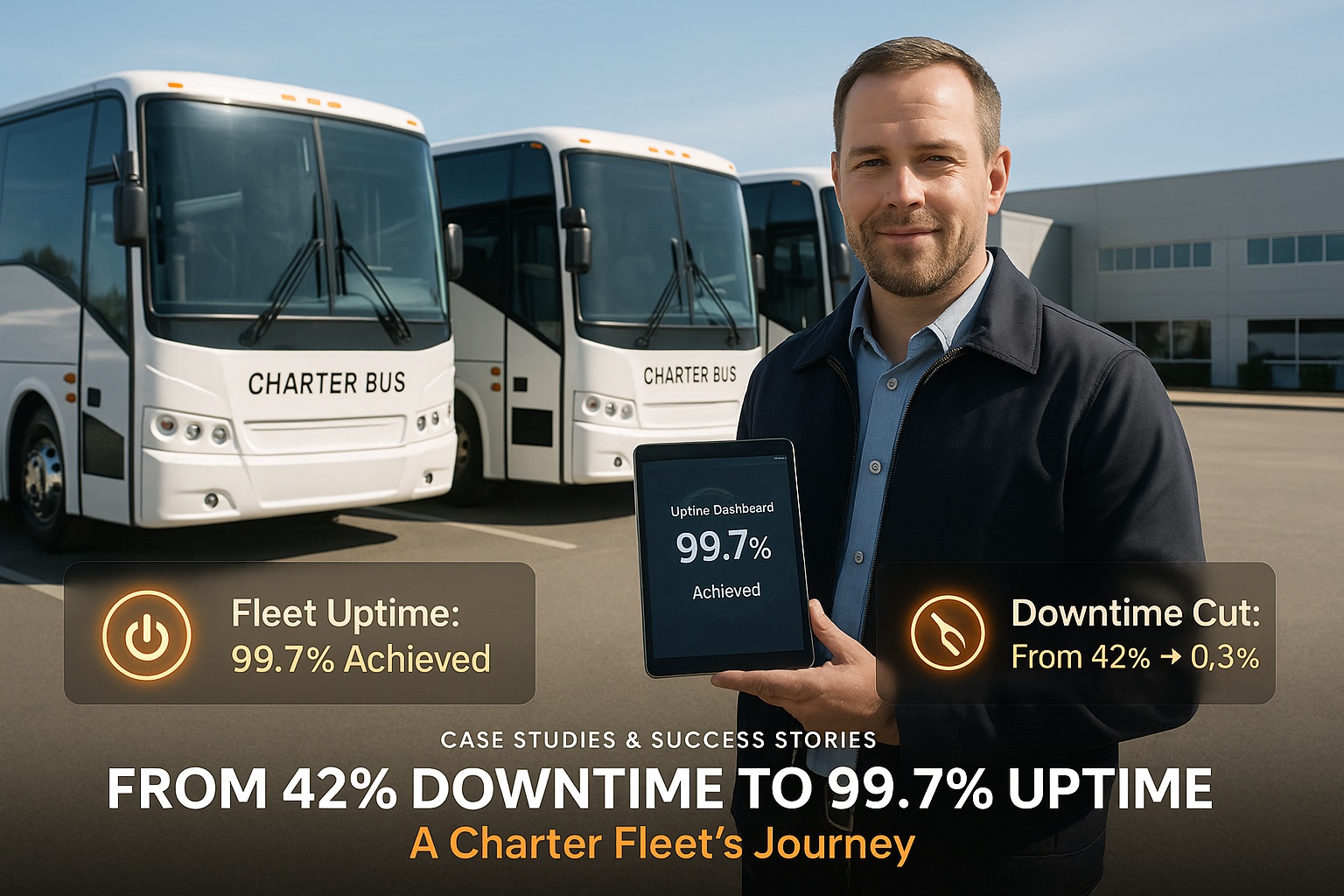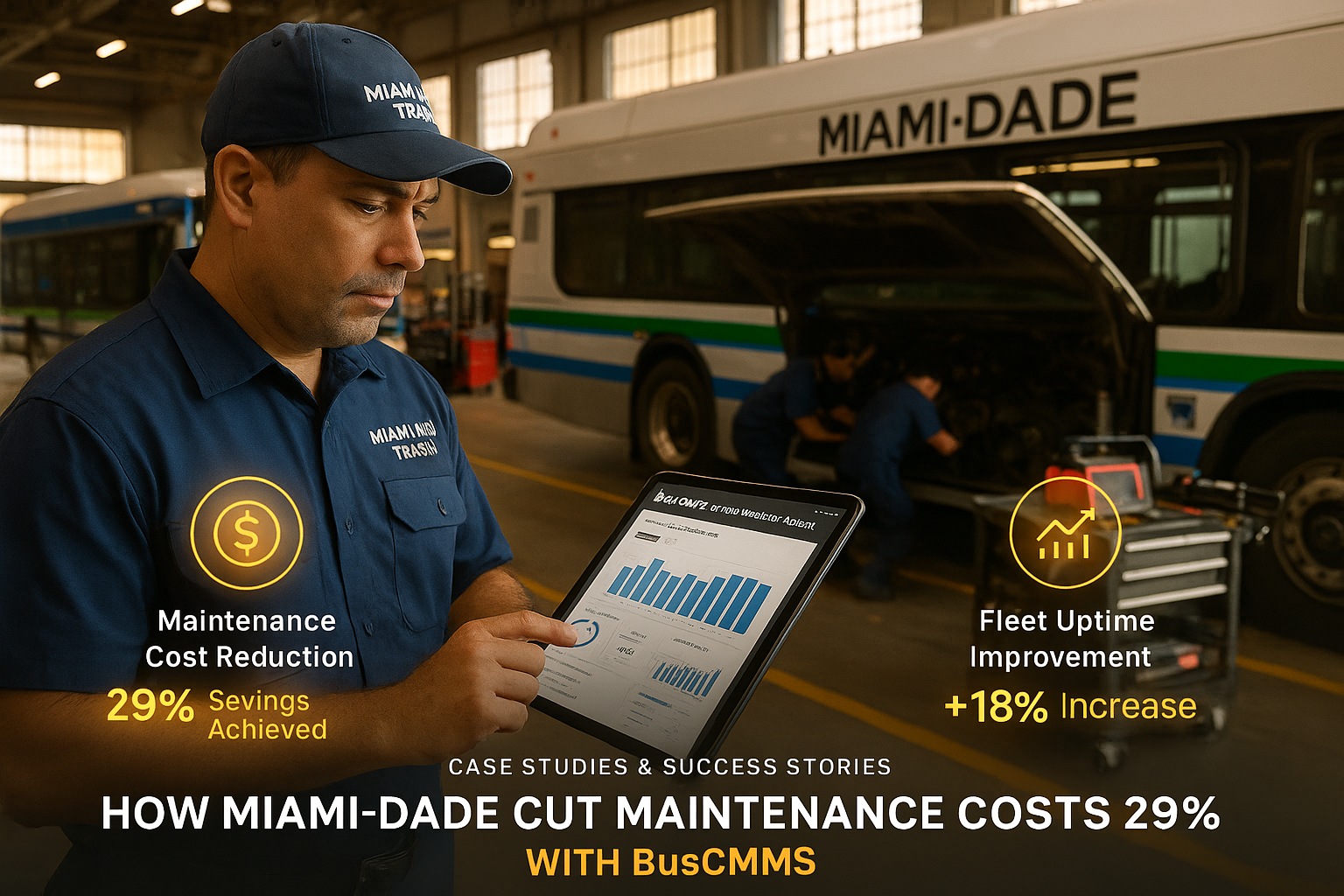Your fleet manager rushes into the monthly review with a crisis: "We've got three buses down waiting for parts, our inventory costs are through the roof, and I just discovered we're sitting on $50,000 worth of obsolete components!" As you analyze the spreadsheets tracking thousands of parts across multiple vendors, you realize your operation is hemorrhaging money through inefficient parts management.
This scenario haunts fleet operations nationwide, reflecting a fundamental challenge in modern bus fleet management. With buses containing over 3,000 unique parts and components, maintaining optimal inventory levels while ensuring availability requires sophisticated management strategies that go beyond traditional min-max approaches.
Industry leaders achieve 35-47% better fleet availability by implementing comprehensive parts management systems that balance inventory costs with operational needs. The key lies in leveraging technology, data analytics, and proven inventory optimization techniques to transform parts management from a necessary evil into a competitive advantage.
Transform your fleet's parts management with proven inventory optimization strategies and real-time tracking systems.
Getting StartedBook a Demo
The Foundation: Understanding Modern Parts Management
Effective bus parts management extends far beyond maintaining shelves of components. It encompasses strategic inventory planning, predictive analytics, vendor relationship management, and integration with maintenance operations to create a seamless system that minimizes costs while maximizing fleet availability.
Modern parts management systems leverage real-time data from multiple sources—maintenance histories, manufacturer recommendations, seasonal patterns, and predictive analytics—to optimize every aspect of the parts lifecycle from procurement through disposal.
Predictive Stocking
AI-driven demand forecasting reduces stockouts by 85% while cutting excess inventory by 30-40%.
Automated Reordering
Smart systems trigger purchases at optimal times, capturing bulk discounts and preventing rush orders.
Quality Tracking
Monitor part failure rates by vendor, enabling data-driven supplier decisions and warranty claims.
Cross-Reference Management
Identify compatible parts across manufacturers, reducing unique SKUs by 20-30%.
Lifecycle Analytics
Track part performance from installation to failure, optimizing replacement intervals.
Integration Excellence
Seamless connection with maintenance schedules ensures parts availability for planned services.
Benefit #1: Dramatic Cost Reduction Through Inventory Optimization
The financial impact of effective parts management extends throughout the organization. By implementing data-driven inventory strategies, fleets typically reduce carrying costs by 25-35% while simultaneously improving parts availability. This apparent paradox—less inventory with better availability—becomes possible through intelligent stocking decisions.
Advanced analytics identify slow-moving inventory that ties up capital, enabling managers to liquidate obsolete stock and redirect resources to high-turnover components. Seasonal adjustment algorithms ensure winter-critical parts are stocked appropriately without year-round carrying costs.
| Cost Reduction Area | Typical Savings | Key Strategy | Implementation Timeline |
|---|---|---|---|
| Carrying Costs | 25-35% | Right-size inventory levels | 3-6 months |
| Emergency Purchases | 60-75% | Predictive stocking | 2-4 months |
| Obsolete Inventory | 80-90% | Lifecycle tracking | 6-12 months |
| Vendor Costs | 15-20% | Consolidated purchasing | 4-8 months |
Strategic vendor negotiations become possible when armed with comprehensive usage data. Fleet managers can commit to annual volumes with confidence, securing significant discounts while maintaining flexibility through blanket purchase orders with scheduled releases.
Benefit #2: Minimized Vehicle Downtime
Every minute a bus sits idle waiting for parts represents lost revenue, disrupted routes, and diminished public trust. Effective parts management directly impacts fleet availability by ensuring critical components are always in stock when needed.
Downtime Reduction Strategy
Modern CMMS platforms integrate parts availability with maintenance scheduling, preventing the frustrating scenario of discovering missing components only after a vehicle enters the shop. This proactive approach reduces maintenance-related downtime by 40-50%.
Ready to slash downtime and optimize your parts inventory? Discover how our advanced CMMS platform transforms parts management.
Getting StartedBook a Demo
Benefit #3: Enhanced Preventive Maintenance Execution
Preventive maintenance programs live or die based on parts availability. When technicians can confidently schedule PM services knowing all required components are in stock, compliance rates soar and vehicle reliability improves dramatically.
PM Compliance
Increase from 75% to 95%+ with guaranteed parts availability
Service Time
Reduce by 30% through pre-kitting and staged parts delivery
First-Time Fix Rate
Improve to 98%+ by ensuring correct parts are always available
Technician Productivity
Increase 25% by eliminating parts-hunting time
Quality Scores
Achieve consistent OEM-quality repairs with certified parts
Cost Per PM
Reduce 20% through efficient parts management
Integration between parts management and maintenance scheduling creates a virtuous cycle: better parts availability enables consistent PM execution, which provides reliable failure data, further improving parts forecasting accuracy.
Benefit #4: Improved Regulatory Compliance
Transportation regulations demand meticulous documentation of parts usage, particularly for safety-critical components. Effective parts management systems automatically maintain comprehensive audit trails that satisfy DOT requirements and protect against liability.
Beyond basic compliance, sophisticated parts tracking enables proactive recall management. Systems automatically flag affected vehicles when recall notices arrive, ensuring timely remediation and maintaining passenger safety. This capability proves invaluable during manufacturer recalls affecting multiple model years or component variations.
Benefit #5: Superior Vendor Management
Effective parts management transforms vendor relationships from transactional interactions to strategic partnerships. Armed with detailed usage analytics, fleet managers negotiate from positions of strength, securing favorable terms while ensuring reliable supply chains.
Performance Metrics
Track on-time delivery, quality scores, and pricing competitiveness across all suppliers.
Strategic Sourcing
Identify opportunities for vendor consolidation or diversification based on risk analysis.
Contract Optimization
Negotiate annual agreements with volume commitments and performance guarantees.
Quality Assurance
Monitor failure rates by vendor, enabling data-driven supplier selection decisions.
Benefit #6: Real-Time Visibility and Control
Modern parts management systems provide unprecedented visibility into inventory status, usage patterns, and costs. Cloud-based platforms enable access from any device, empowering managers to make informed decisions whether in the office or on the shop floor.
2025 Technology Capabilities
- Mobile barcode scanning for instant inventory updates and usage tracking
- IoT sensors monitoring high-value parts locations and environmental conditions
- AI-powered demand forecasting with 95%+ accuracy for critical components
- Automated vendor portals enabling direct supplier integration
- Blockchain verification for parts authenticity and chain of custody
- Predictive analytics identifying failure patterns before they impact operations
Benefit #7: Streamlined Warranty Recovery
Warranty recovery represents one of the most overlooked benefits of effective parts management. Many fleets leave thousands of dollars unclaimed due to poor documentation or missed deadlines. Automated warranty tracking ensures every eligible claim gets submitted and recovered.
Comprehensive parts histories enable successful warranty claims by providing indisputable documentation of installation dates, failure circumstances, and associated labor costs. This detailed tracking transforms warranty recovery from an administrative burden into a reliable revenue stream.
Benefit #8: Environmental Sustainability
Effective parts management contributes significantly to environmental goals through waste reduction, recycling optimization, and extended component lifecycles. By maintaining optimal inventory levels, fleets minimize disposal of expired or obsolete parts while maximizing core return values.
Sustainability initiatives supported by parts management include:
Green Fleet Strategies
- Remanufactured parts programs reducing raw material consumption by 60%
- Oil and filter recycling tracking ensuring 100% proper disposal
- Battery management systems maximizing lifespan and recycling value
- Tire retreading programs extending casing life by 2-3 cycles
- Hazardous material tracking ensuring compliant handling and disposal
- Parts lifecycle extension through preventive maintenance optimization
The eight benefits of effective bus parts management create compelling returns across operational, financial, and environmental dimensions.
From immediate cost savings through inventory optimization to long-term improvements in fleet reliability and regulatory compliance, comprehensive parts management touches every aspect of fleet operations. US manufacturing professionals who embrace these systems position their organizations for sustained competitive advantage.
The path forward requires commitment to technology adoption, process improvement, and cultural change. However, organizations making this investment consistently report transformational results—operating more efficient, reliable, and profitable fleets while better serving their communities. The question isn't whether to implement effective parts management, but how quickly you can begin capturing these benefits.
Take control of your fleet's parts inventory today. Join thousands of fleet managers who've transformed their operations with smart parts management.
Getting StartedBook a Demo








